Period: 1920
A History of Fashion and Costume
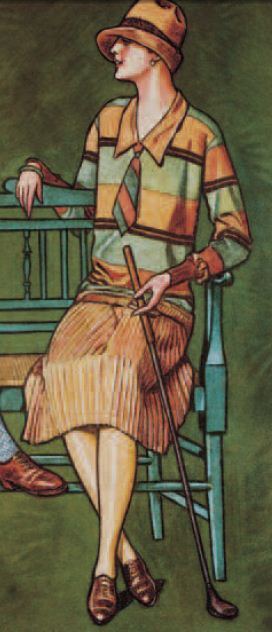

The model on this picture is wearing a fur trim jacket from Bisou Bisou that has been clearly influenced by the fashion of 20’s (the color-matching and comparatively narrow fur collar reaches almost down the waistline). The short silk dress is also reminiscent of Art Deco style, closely associated with women’s fashion from 20’s. Pearle necklace hangs down loosely, while reaching down almost to the waistline – thus, giving model’s twentieth look a final touch. (Cosmopolitan, 2009, p. 75).

This model’s dress from Hermes has an undeniable aura of Art Deco style about it – it is asymmetric, it conceals model’s feminine proportions, it implies a great freedom of movement. The color-matching belt strengthens the impression of assymetricity about model’s appearance, which invokes images of flappers from 20’s. The silk scarf, wrapped around model’s head, radiates a spirit of twentieth unconventionality even further. (Vogue, [Russian edition], 2010 Spring-Summer Collection, p. 5).

There can be very little doubt that this dress from Glambattista Valli has been inspired by fashion from 20’s, as it features decorative fringe rather prominently. Just as it is being the case with the dress displayed earlier, its designer had made a point in trying to provide wearer with a complete freedom of movement, which explains the absence of clearly defined waistline in this dress – a common feature of women’s fashion from twenties. Model’s shoes also appear to have been inspired by stylistic trends from the same historical era, due to ankle-straps as the foremost element of their design. (Vogue, [Russian edition], 2010 Spring-Summer Collection, p. 17).
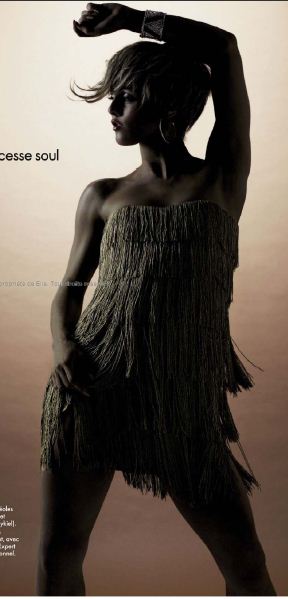
On this picture, Vanessa Paradise is shown wearing 2009 dress from Jay Ahr. The fact that this dress is made almost exclusively of decorative fringe invokes strong connotations with the fashion of twenties. Vanessa’s ear-rings and the massive silver bracelet, worn on her left hand, intensifies the extravagance of her frivolous appearance, which in its turn, points out at designer’s rather comprehensive understanding of an aesthetic values, associated with a so-called ‘flapper style. (Elle, 2009 [French edition], p. 102).
Period: 1930
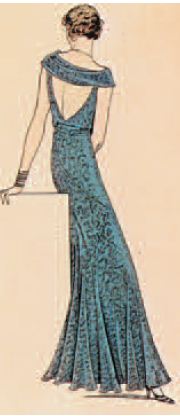
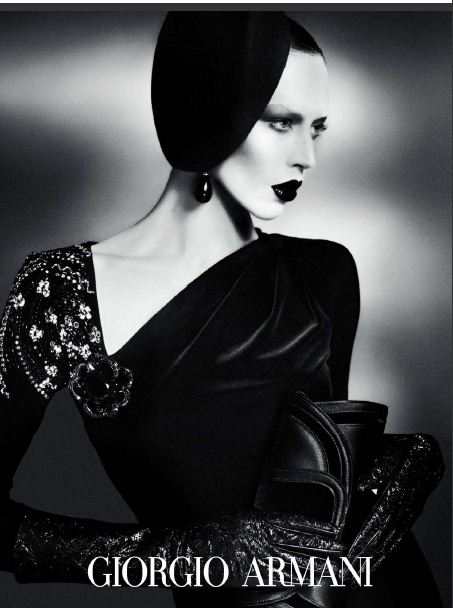
The model on this advertisement image from Giorgio Armani emanates a strong spirit of thirties, due to the following: a) Monochromatic homogeneity of her dress and accessories, b) The fact that her dress is being simultaneously tight and long, c) The sheer length of her black suede gloves, d) Tear-shaped design of her beret, e) The strength of her facial makeup’s expressiveness (to emphasize face’s rectangular features). The reason why this picture features only black and white colors is to prompt viewers to establish a connotation between model’s appearance and black and white movies from thirties. (Vogue, 2009, p. 12).
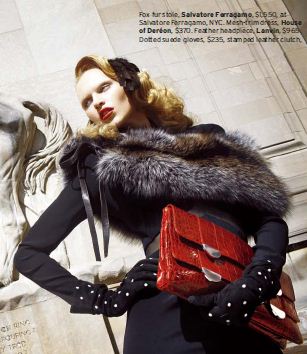
On this picture, model wears mesh-trim dress from House of Dereon and fox fur stole from Salvatore Ferragamo. The combination of these two items endows model with clearly defined thirtieth charm, which is being strengthened even to a further expect by the fact that her attire includes long gloves, decorated with white pearl beads, and a feather headpiece. Model’s hairstyle also results in producing strong invocations with thirties – it was namely during the course of this historical period that a so-called ‘peroxide blond’ hairstyle had gained a strong fashionable prominence. (Elle, 2009, p. 167).
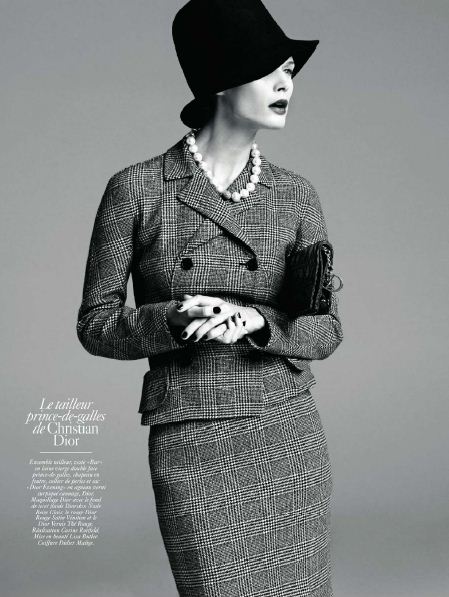
Even though the model on this picture looks as if she just came from thirties on a time machine, she is actually wearing items from Christian Dior 2009 Autumn collection. These items include: a black slouch hat (with its height being intentionally hypertrophied), double-sided woolen jacket and a matching skirt of the same material, white pearls necklace, and a hand-bag made from black leather. A design of all of these items is being specifically adjusted to invoke 30’s-based motifs of female sophistication. (Vogue, 2009 [French edition], p. 125).

On this picture, model wears a shiny ‘bandage dress’ from Pamella Roland, made of lurex. These types of evening dresses used to be considered particularly fashionable during the course of thirties, when a whole range of new fabrics became available for Haute Couture fashion designers. After the end of twenties, it represented a common trend among designers to place accent back onto emphasizing the curves of a female body, which explains why it was in thirties that the concept of S-shape had firmly re-established itself in the world of fashion for another few decades. The fact that depicted model has a long blond hair intensifies the subtleties of her ‘thirtieth’ elegance. (Elle, 2009, p. 183).
Period: 1940
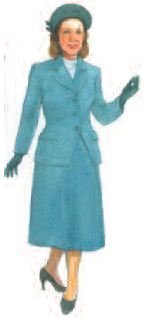

On this picture, a model is shown wearing forties-inspired suit from Juicy Couture. The reason why we were able to define this suit as relating to the fashion style of forties is due to its aesthetic simplicity and also due to the fact that it features no clearly visible decorative elements. During the time of WW2, there was a scarcity of fabrics, which explains why fashion designers of the era had very little freedom while experimenting with introduction of new stylistic elements. Apparently, the designer of presented outfit was well aware of this fact. (Elle, 2009, p. 128).
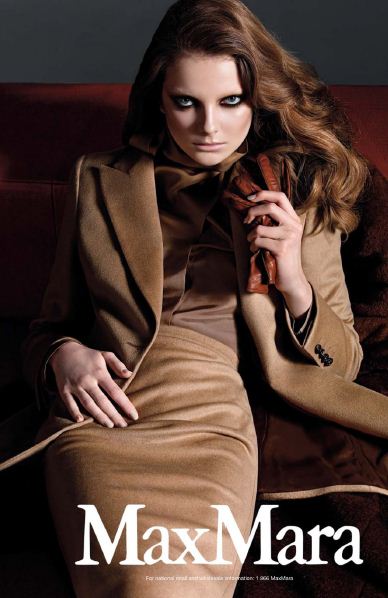
This picture represents another example of a designer’s product, inspired by fashionable spirit of forties, even though we can only imply it to a certain extent. On it, model is wearing a two-piece suit from Max Mara, the main stylistic feature of which is its monochromatic and decorative minimalism. The design of suit’s collars is being concerned with an appeal to manliness. However, suit’s fabric (cashmere) and the fact that model’s hairstyle is not exactly fortyish-looking, considerably lessens the ‘back in time’ observational effect. (Elle, 2009, p. 75).

On this picture, model is wearing floral printed dress from Pennyblack, which invokes the spirit of forties’ fashion rather directly, due to: dress’s fabric (crape), the color, size and shape of printed flowers, and its clearly visible tailored design. It was namely during the course of forties that crape had gained a peak of its popularity as fabric for dresses and skirts, because of its affordability. Nevertheless, model’s slick hairstyle and also the fact that she wears jacket over the dress, lessens the intensity of her fortyish charm. (Glamour [Russian edition], 2009, p. 27).
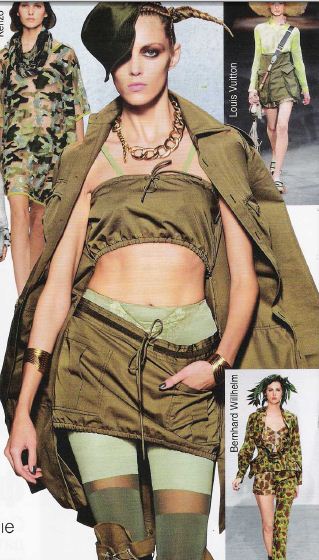
During the time of WW2, many military-based items of men’s clothing became an integral part of women’s wardrobe, because throughout the course forties, women played an active role in helping their countries’ war-effort. On this picture, model is shown wearing khaki-colored military hat and overcoat from Jean Paul Gaultier. The reason why we define both items as being inspired by women’s military fashion of forties is that their design implies practical functionality, as opposed to aesthetic extravagance, associated with para-military unisex style of nineties. Of course, this suggestion does not apply to model’s skirt, leggings and bra. (Vogue, [Russian edition], 2010 Spring-Summer Collection, p. 13).
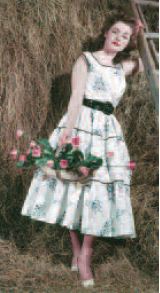
Period: 1950
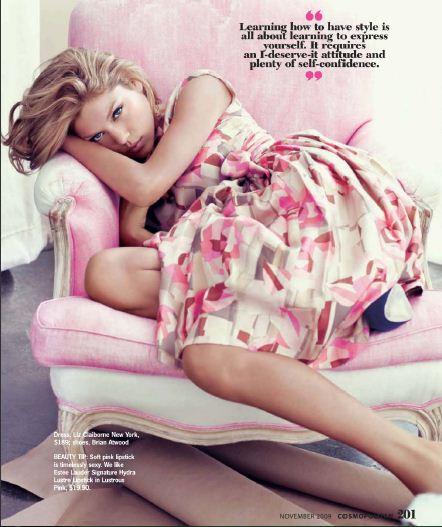
On this picture, model is shown wearing a dress from Liz Claiborne, which is appears being clearly inspired by stylistic trends that dominated in the fashion of fifties: floral prints on fabrics, bell-skirts, strongly emphasized waist-line. Her hairstyle does not quite match the ones that used to be popular with women in fifties. The same can be said about model’s facial makeup (minimalist). Nevertheless, there can be very little doubt as to the fact that, while creating it, dress’s designer never ceased being influenced by fashion trends, associated with specifically this historical period. (Cosmopolitan, 2009, p. 201).
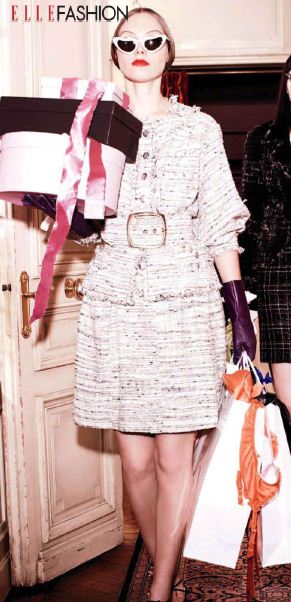
The model on this picture is wearing a two-piece woolen suit from Luca Karati. Her appearance has a variety of stylistic features from fifties to it. The most prominent of them is large buckle on the belt and cat-eye sunglasses, which used to be very popular with women throughout fifties and early sixties. The only thing, which hints as to the fact that this photo was not taken in actual fifties, is the fact that model has her sleeves tucked up – back then, this would have been considered overly informal. (Elle, 2010, p. 103).
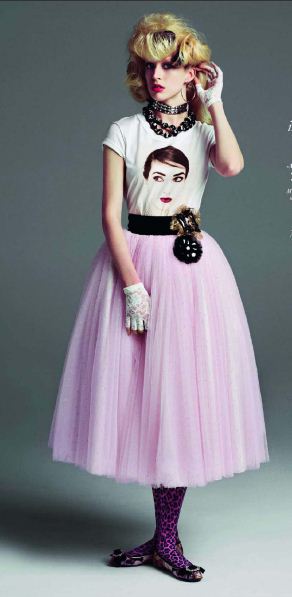
Even a brief glance at this picture will reveal model’s attire from Chanel as such that has been directly inspired by the youth-fashion of fifties, due to attire’s following elements: poodle skirt, modified saddle shoes, and decorated black belt that emphasizes the thinness of a waist-line. Nevertheless, the ‘back in fifties’ impression is being somewhat lessened by the fact that model’s aggressively colored stockings and t-shirt are unmistakably from eighties. (Vogue, 2009, p. 164).

The model presented in this picture, is wearing Chanel’s three items of clearly ‘fiftyish’ origin: a white tailored jacket, a modified bell-skirt, and a black chic-hat. The appearance of these items is being concerned with designer’s desire to emphasize model’s femininity and the fact that she fits for the role of a ‘trophy wife’. In its turn, this suggests that, while creating this specific outfit, Chanel’s designer did in fact draw inspiration from fifties. Nevertheless, the leather boots featured in this picture appear being influenced by stylistic trends from sixties, rather than from fifties. (Elle, 2010, p. 5).
Period: 1960
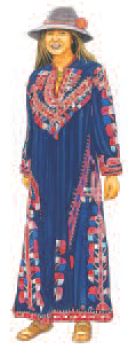
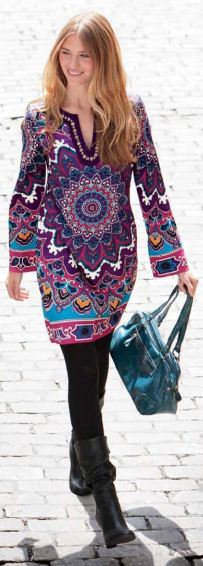
This picture depicts model wearing sixties-styled tunic from Nicole, which immediately invokes images of ‘flower children’ from sixties. The impression of model’s association with ‘liberating sixties’ is being strengthened even further by an undeniably sixties-styled handbag, she carries, and by her loosely hung hair, which is meant to emphasize woman’s intellectual open-mindedness. The fact that model does radiate spirit of sixties in rather straightforward manner can also be explained by the absence of items which would relate to another historical periods about her appearance. (Cosmopolitan, 2009, p. 5).
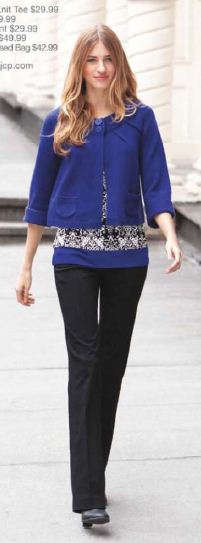
Another piece of sixties-styled clothing from Nicole. On this picture, the same model is wearing a cardigan with only two upper buttons and with sixtyish-looking decorative pockets on cardigan’s sides. Model’s appearance implies certain looseness about her proportions – a distinctive feature of a fashion style associated with ‘sexual liberation’ of sixties. In its turn, this also explains why despite black trousers’ apparent tightness, they do not seem to accentuate model’s bodily curves even slightly. (Cosmopolitan, 2009, p. 13).
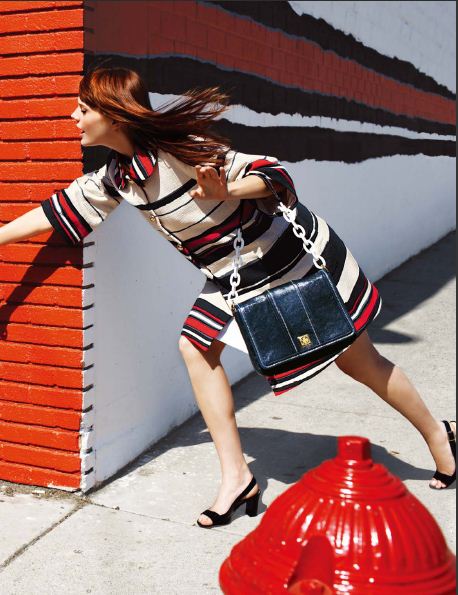
On this picture, model is shown wearing sixties-styled overcoat, handbag and shoes from Kate Spade. The most distinctive features of her overcoat are its coloring (asymmetrical stripes of red and black, parallel to the waistline) and the fact that it does not extend below model’s knees (this endows her with strongly-defined sixtyish look). The stylistic appearance of rectangular-shaped heels on model’s shoes, accentuates her youthfulness and intellectual openness to new ideas (as opposed to conservative attitudes of older women from the same historical period, which used to wear more conventionally looking shoes). (Elle, 2009, p. 71).
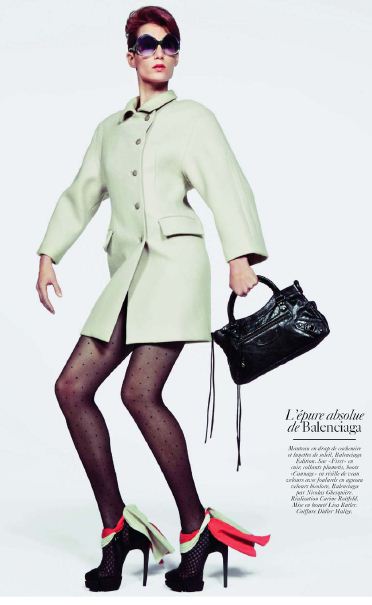
Even though the fabric of model’s overcoat from Balenciaga (cashmere) is strongly associated with the fashion of nineties, its design is undeniably sixtyish (large color-matching buttons, a hypertrophied shortness of a hemline, closed collar). The other sixties-styled elements of model’s attire include a designer handbag and sunglasses (teashades). If it was not up to shoes’ high heels, their design would have been also considered perfectly sixtyish. (Vogue [French edition], 2009, p. 168).
Period: 1970
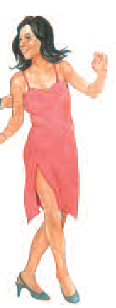
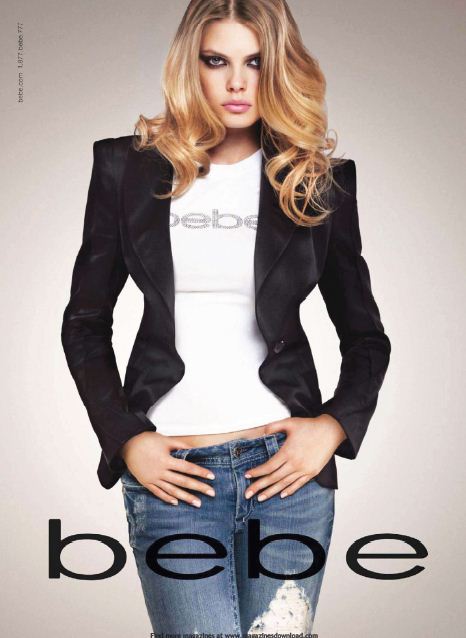
During the course of seventies, a design of women’s jackets has been progressively influenced by that of men’s suits. On this picture, model wears a flannel jacket from Bebe, which appears being influenced by fashion trends of seventies (open collar, shoulder pads). When combined with designer worn out jeans and white t-shirt, this jacket endows model with a hippyish appearance, which in its turn, is being reminiscent of seventies era. (Cosmopolitan, 2010, p. 48).
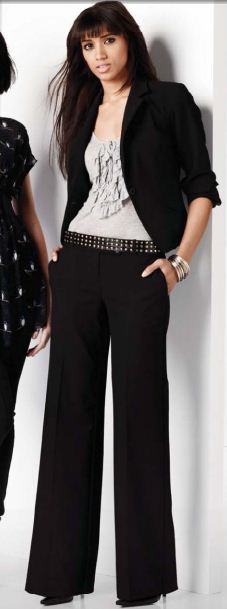
On this picture, model is wearing two garments from Nicole, the design of which has been influenced by the fashion of seventies: flared trousers and a top tank with a decorative frills on it. The bracelet on model’s left hand strengthens the impression of her being affiliated with the fashion of seventies even more. The same can be said about high-heel shoes, but only to a certain extent – as for the fashionable trends of seventies, the heels on these shoes appear overly pointy and narrow. (Cosmopolitan, 2009, p. 85).

This picture can serve as a perfect illustration as to how stylistic trends of seventies find their way into the fashion of 2009-2010. On it, model is shown wearing seventyish-styled denim jacket, hairpiece (Afro hairdo) and a single-strap denim bag from Louis Vuitton. The only thing about model’s attire that appears being unrelated to the stylistic fads of seventies is whimsically looking shoes (they are clearly the by-product of designer’s own creative genius). Massive green bracelet on model’s right hand adds even more to her extravagant looks that invoke the spirit of seventies. (Vogue, [Russian edition], 2010 Spring-Summer Collection, p. 7).

On this picture, we get to see another proof as to the fact that it is much too early to refer to the fashion of seventies as such that is has been gone forever. Even a brief glance at model’s flared jeans from Phillip Lim, elastic polo-neck sweater from Lacoste and platform shoes from Christian Louboutin, substantiates the validity of this suggestion perfectly well. The model would appear even more seventyish if she did not wear man’s fedora hat, closely associated with the fashion of thirties. (Glamour, 2009, p. 104).
Period: 1980
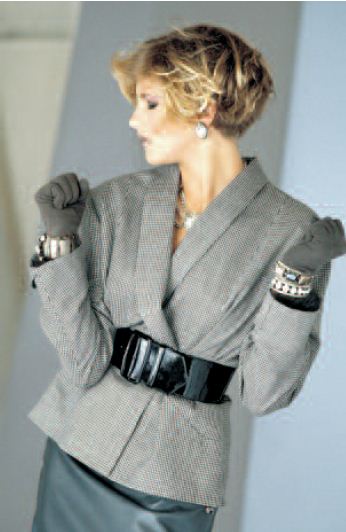
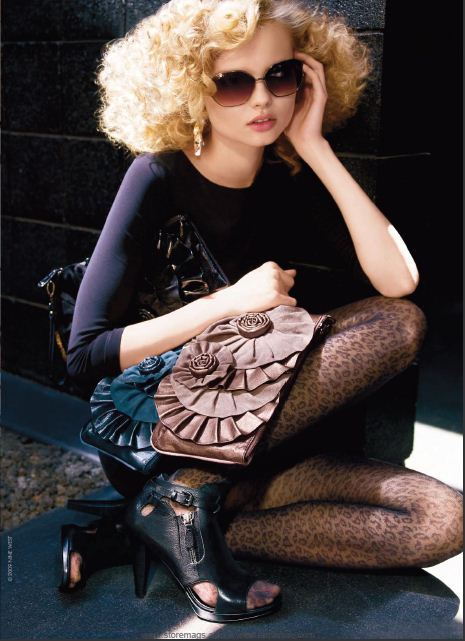
On this picture, model is shown wearing a number eighties-inspired accessories from Nine West (a designer handbag decorated with frilly ornament, ivory ear-rings, sunglasses). Moreover, her patterned stockings and closed high-heel shoes also appear to have been inspired by the trends that dominated in women’s fashion of eighties. Model’s hairstyle emphasizes her eightyish appearance even more, because it was namely during the course of eighties that women strived to add volume to their hair as yet another proof as to their fashion-mindedness. (Elle, 2009, p. 53).

The model on this picture is wearing a so-called ‘parachute pants’ from Chloe – one of the most distinctive fashionable trademarks of eighties. Her sweatshirt from Marc Jacobs with prominently padded shoulders and with patchwork decoration, matches these pants perfectly well – back in eighties, this type of sweatshirts was considered very trendy. Model’s straight-cut hairstyle is also being reminiscent of eighties. (Elle, 2009, p. 348).
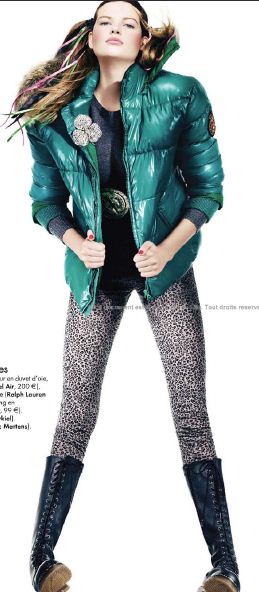
There are two eighties-related pieces of clothing on this model – a ‘puffa’ jacket from Bel Air and patterned leggings from Claudie Pierlot. These items do emanate the spirit of women’s fashion from eighties rather directly, even though that this spirit is being weakened somewhat by the fact that model also wears ‘martens’ (boots), closely associated with the subculture of Goths and Skinheads from nineties. (Elle [French edition], 2009, p. 156).
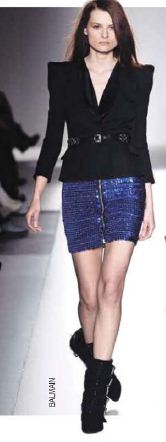
On this picture, model is shown wearing tailored jacket, denim skirt and leather ‘rebel’ boots from Balmain. The design of all three items has been heavily affected by the fashion of eighties (clearly defined shoulder pads, mismatching colors of jacket and skirt and a plenty of decorative buckles on boots). The only ‘non-eightyish’ element of model’s appearance is her hairstyle. (Cosmopolitan, 2009, p. 78).
Period: Romantic
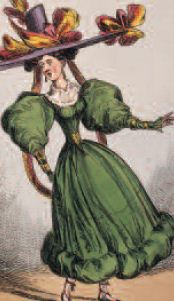

On this picture, model is shown wearing jacket from Bebe, the design of which has been clearly affected by fashionable trends from Romantic era. The most prominent feature of this design is mutton sleeves, which add rather substantially to model’s overall extravagant appearance. Model’s volumous hairstyle matches the upper part of her outfit quite nicely, even though it appears to be related to Victorian rather than Romantic era. (Cosmopolitan, 2009, p. 6).
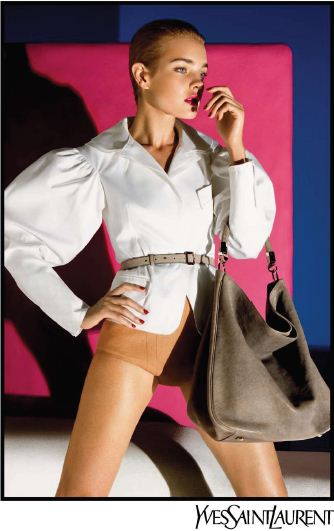
The same can be said about model’s jacket from Yves Saint Laurent, shown on this picture – jacket’s mutton sleeves leave no doubt as to the fact that, while creating it, its designer drew inspiration out of Romantic fashions (this also explains the specifics of jacket’s tailoring). It is needless to mention, of course, that model’s hairstyle and the fact that she is wearing shorts have nothing to do with fashionable trends from Romantic era. (Elle, 2010, p. 23).
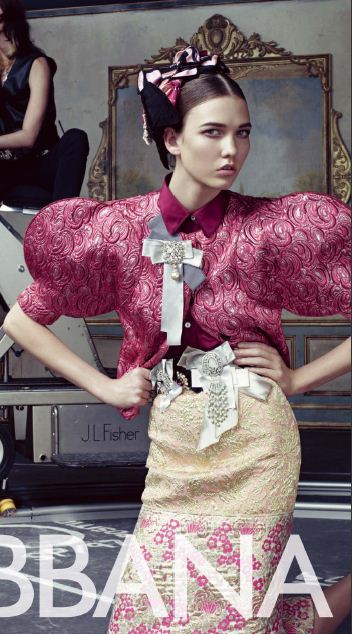
This picture can be referred to as another example of how the fashion of Romantic era affects the works of contemporary fashion designers. On it, the model is being depicted wearing blouse from Dolce & Gabbana with hypertrophied mutton sleeves, which radiates the spirit of Romantic trendiness. The presence of decorative ribbons on model’s blouse and skirt intensifies this spirit even further. However, it appears that the design of model’s skirt has been inspired by fashionable trends from 20th century. In its turn, this creates a peculiar aesthetic effect about model’s overall appearance. (Elle, 2009, p. 19).
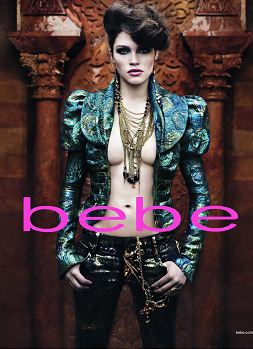
On this picture, we get to see another example of how Bebe’s designers exploit Romantic fashion’s motifs in the line of their works. Just as it is being the case with picture (A), the model on this illustration is wearing whimsically designed jacket from Bebe, which features mutton sleeves rather prominently. It would help the cause of promoting the spirit of Romantic fashion considerably, if model wore something underneath that jacket. (Vogue [French edition], 2009, p. 92).
Period: Empire
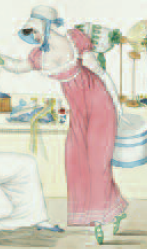
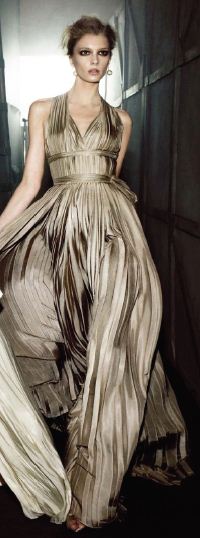
On this picture, model is wearing dress from Bottega Veneta, which appears being inspired by an Empire fashion (particularly high waistline, the absence of movement-restricting elements). If this dress was ‘equipped’ with a low-cut and if it was pink or blue, there would have been indeed very little difference between this model’s appearance and the appearance of a woman from the historical image above. (Elle, 2009, p. 23).
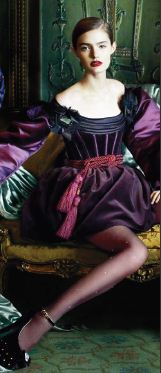
This picture represents another example of an Empire fashion style at work – model’s dress from Dolce & Gabbana features two unmistakable elements of this particular style: a tassel belt and a low-cut. Despite the fact that dress’s waistline does not seem being particularly high, model certainly does emanate the spirit 19th century’s early twenties. This impression is being strengthened even further by particulars of illustration’s background. (Elle, 2009, p. 18).
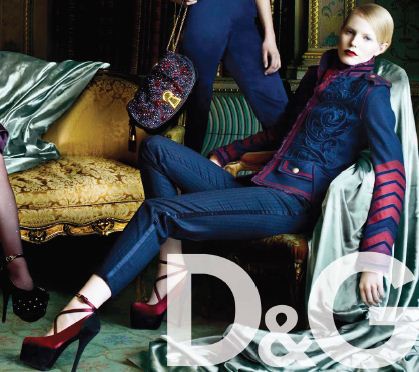
This picture is particularly interesting, within the context of how the elements of an Empire men’s fashion style are being presented in contemporary designer pieces for women. On it, model is wearing jacket from Dolce & Gabbana that is being reminiscent of French hussars’ uniform from early 19th century. Another element of this style is ‘general stripes’ on right and left sides of model’s pants. (Elle, 2009, p. 19).
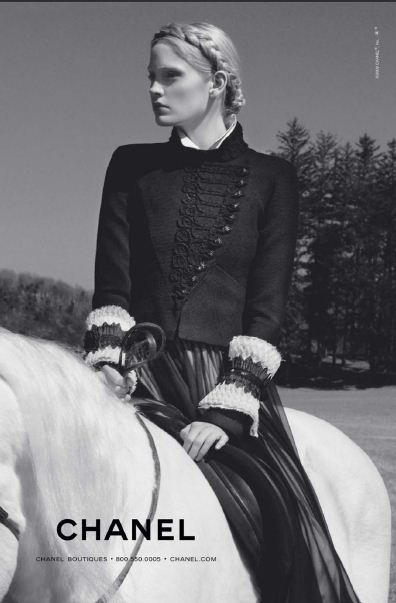
On this picture, model is wearing jacket (dolman) from Chanel that is being designed in accordance to the canons of an Empire men’s military fashion. Jacket’s most prominent decorative feature, which invokes the images of hussars, is its braided front-side. Given skirt’s apparent shapelessness, it appears that it has also being designed with the images of an Empire style in mind. (Elle, 2009, p. 496).
Period: Edwardian
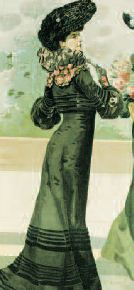
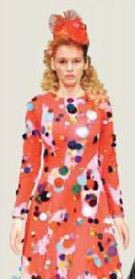
Despite the fact that colors of a dress from Bas Kosters, shown in this picture, can be referred to as anything but Edwardian, dress’s shape and its proportions do correspond to what used to be the standards of Edwardian women’s fashion (skirt’s hemline reaching down to the floor, the absence of bustles). Model’s decorative hat is meant to emphasize the thinness of her neck – another common feature of Edwardian fashion style. (Elle, 2010, p. 122).
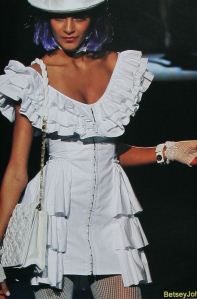
On this picture, model is shown wearing dress from Betsy Johnson, which has two elements of Edwardian style to it: frilly décolleté and frills along dress’s both sides. It is needless to say, of course, that this dress is being not even nearly long enough to be considered as such that closely relates to Edwardian fashion style. Nevertheless, it does invoke the spirit of ‘awakening femininity’, associated with aesthetic values of this historical fashion style. (Top Fashion Dress, 2009, p. 67).
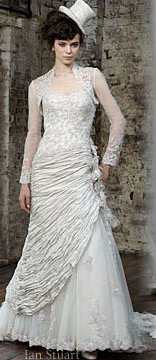
Given the apparent impracticality of long mantles, associated with Edwardian-styled dresses, it comes as no surprise that contemporary fashion designers usually refrain from utilizing the elements of this style in their prêt-à-porter collections. Nevertheless, as it can be seen on this picture, the utilization of Edwardian style remains quite popular with designers who specialize in creating wedding dresses. The presented wedding dress from Ian Stuart is clearly Edwardian (long mantle, frilly petticoats, decorative hat). (Glamour, 2009, p. 15).
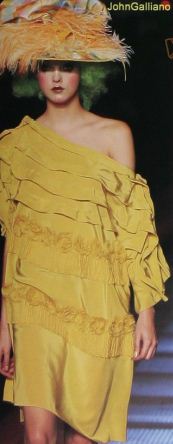
On this picture, model is wearing one accessory of unmistakably Edwardian inspirational origin – a heavily feathered hat from John Galliano. As we have mentioned earlier, these types of hats used to be particularly popular with women during the first decade of twentieth century, due to their ability to visually increase wearers’ height. However, model’s dress represents a striking dichotomy with Edwardian style. (Top Fashion Dress, 2009, p. 7).
Bibliography
Balenciaga. Advertisement. Vogue [French edition] 2009: 168. Print.
Balmain. Advertisement. Cosmopolitan 2009: 78. Print.
Bas Kosters. Advertisement. Elle 2010: 122. Print.
Bebe. Advertisement. Cosmopolitan 2009: 6. Print.
Bebe. Advertisement. Cosmopolitan 2010: 48. Print.
Bebe. Advertisement. Vogue [French edition] 2009: 92. Print.
Betsy Johnson. Advertisement. Top Fashion Dress 2009: 67. Print.
Bisou Bisou. Advertisement. Cosmopolitan. 2009: 75. Print.
Bottega Veneta. Advertisement. Elle 2009: 23. Print.
Chanel. Advertisement. Elle 2010: 5. Print.
Chanel. Advertisement. Elle 2009: 496. Print.
Chanel. Advertisement. Vogue [French edition] 2009: 164. Print.
Chloe. Advertisement. Elle 2009: 348. Print.
Christian Dior. Advertisement. Elle [French edition] 2009: 125. Print.
Claudie Pierlot. Elle [French edition] 2009: 156. Print.
Dolce & Gabbana. Advertisement. Elle 2009: 19. Print.
Dolce & Gabbana. Advertisement. Elle 2009: 18. Print.
Dolce & Gabbana. Advertisement. Elle 2009: 19. Print.
Giorgio Armani. Advertisement. Vogue [French edition]. 2009: 12. Print.
Glambattista Valli. Advertisement. Vogue [Russian edition] Collection 2010: 17. Print.
Hermes. Advertisement. Vogue [Russian edition] Spring-Summer Collection 2010: 5. Print.
Hibbert, Adam & Hibbert, Clare. A History of Fashion and Costume (volumes 7/8). New York: Bailey Publishing Associates Ltd. 2005. Print.
House of Dereon/Salvatore Ferragamo. Advertisement. Elle 2009: 167. Print.
Ian Stuart. Advertisement. Glamour 2009: 15. Print.
Jay Ahr. Advertisement. Elle [French edition] 2009: 102. Print.
Jean Paul Gaultier. Advertisement. Vogue [Russian edition] Spring-Summer Collection 2010: 13. Print.
John Galliano. Advertisement. Top Fashion Dress 2009: 7. Print.
Juicy Couture. Advertisement. Elle 2009:128. Print.
Kate Spade. Advertisement. Elle 2009: 71. Print.
Liz Claiborne. Advertisement. Cosmopolitan 2009: 201. Print.
Louis Vuitton. Advertisement. Vogue [Russian edition] Spring-Summer Collection 2010: 7. Print.
Luca Karati. Advertisement. Elle 2010: 103. Print.
Max Mara. Advertisement. Elle 2009: 75. Print.
Nicole. Advertisement. Cosmopolitan 2009: 13. Print.
Nicole. Advertisement. Cosmopolitan 2009: 5. Print.
Nicole. Advertisement. Cosmopolitan 2009: 85. Print.
Nine West. Advertisement. Elle 2009: 53. Print.
Pamella Roland. Advertisement. Elle 2009: 183. Print.
Pennyblack. Advertisement. Glamour [Russian edition] 2009: 27. Print.
Phillip Lim/Lacoste/Christian Louboutin. Advertisement. Glamour 2009: 104. Print.
Yves Saint Laurent. Advertisement. Elle 2010: 23. Print.